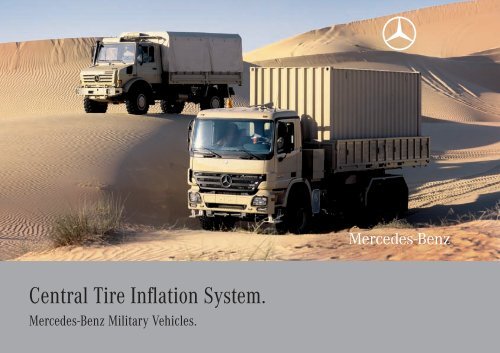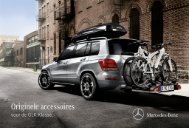Central Tire Inflation System. - Mercedes-Benz
Central Tire Inflation System. - Mercedes-Benz
Central Tire Inflation System. - Mercedes-Benz
Create successful ePaper yourself
Turn your PDF publications into a flip-book with our unique Google optimized e-Paper software.
<strong>Central</strong> <strong>Tire</strong> Infl ation <strong>System</strong>.<br />
<strong>Mercedes</strong>-<strong>Benz</strong> Military Vehicles.
<strong>Central</strong> <strong>Tire</strong> Infl ation <strong>System</strong> (CTIS) for Off-Road Vehicles.<br />
To improve traction on soft and sandy surfaces, for example, <strong>Mercedes</strong>-<strong>Benz</strong> has developed a tire<br />
pressure control system for single-tire, all-wheel-drive vehicles to enhance the outstanding, inherent<br />
off-road characteristics of such trucks.<br />
Reducing the air pressure in the tyres increases the tire<br />
contact area (footprint) and lowers the specifi c ground<br />
pressure. Depending on the ground conditions and tire air<br />
pressure, twice as much traction can be achieved.<br />
<strong>Mercedes</strong>-<strong>Benz</strong> all-wheel-drive vehicles fi tted with a tire<br />
infl ation system can traverse even the toughest of terrains –<br />
whether muddy fi elds, desert sand dunes, climbing<br />
grass-covered embankments or fording rivers. The vehicle<br />
tackles obstacles like these easily and safely.<br />
50<br />
40<br />
30<br />
20<br />
10<br />
Traction force in kN<br />
1.5 2 2.5 3.5<br />
<strong>Tire</strong> pressure in bar<br />
3 bar<br />
2 bar<br />
1 bar<br />
3.2 t 4.7 t 6.3 t<br />
The tire infl ation system not only increases vehicle mobility<br />
and reliability when moving, it also helps to ensure that<br />
a need for vehicle recoveries is avoided as far as possible.<br />
It also prevents unnecessary damage to fi elds. Moreover,<br />
simple adjustments to correct the air pressure ultimately<br />
reduce tire wear.<br />
The <strong>Central</strong> <strong>Tire</strong> Infl ation <strong>System</strong> (CTIS) enables drivers<br />
to adjust the tire pressure while driving to match the<br />
relevant ground conditions. The tires on the front and rear<br />
axles can be regulated together or separately. This option<br />
is not available for the Semi <strong>Tire</strong> Infl ation <strong>System</strong> (STIS).<br />
The driver can quickly reduce the air pressure from 7 to<br />
2 bar, for example, and can then increase it again almost<br />
just as quickly. Depending on the version in question, the<br />
pressure of each tire can be monitored via pressure gauges.<br />
The tire infl ation system is also guaranteed to function<br />
reliably across an extreme temperature range: -40°C to<br />
+80°C. <strong>Mercedes</strong>-<strong>Benz</strong> vehicles off er various types of tire<br />
pressure control systems.<br />
<strong>Central</strong> <strong>Tire</strong> Infl ation <strong>System</strong> 3
4<br />
Semi <strong>Tire</strong> Infl ation <strong>System</strong> (STIS). This system only<br />
allows the tire pressure to be adjusted when the vehicle<br />
is at a standstill. The driver pre-selects the required tire<br />
pressure on a control panel, and then - after the connecting<br />
hoses have been fi tted – adjusts the tire pressure as<br />
required.<br />
<strong>Central</strong> <strong>Tire</strong> Infl ation <strong>System</strong> (CTIS). The control system<br />
switches are mounted within easy reach on the dashboard.<br />
Pressure gauges display the tire pressures separately<br />
for front and rear axles during the infl ation or<br />
defl ation process to enable the driver to adjust the tire<br />
pressure accurately for diff erent load and operating conditions.<br />
The driver can set maximum air pressure levels.<br />
A safety device ensures that these limits are not exceeded.
The driver can continue the journey, even if there is minor<br />
tire damage, because the system can provide a continuous<br />
supply of air. If the tire damage is more severe, however,<br />
the driver can close the blocking valves on the serviceable<br />
tyres. The entire air volume is then sent to the damaged<br />
tire. If the control system malfunctions, the tyres can be<br />
manually supplied by means of additional tire infl ation<br />
valves. The pressure relief system is switched off when<br />
moving, and the tire pressure level is no longer displayed.<br />
Automatic <strong>Central</strong> <strong>Tire</strong> Infl ation <strong>System</strong> (CTIS). This system<br />
allows tire pressures to be set at specifi c values in the<br />
control unit. The driver can then select them to suit the<br />
prevailing ground conditions.<br />
The tire pressure control system is mounted above the<br />
windshield and can be used to pre-select tire pressures for<br />
driving on solid surfaces (roads), on slightly soft surfaces<br />
(off -road) or on particularly soft surfaces (sand and mud).<br />
In emergencies, a special switch can be used to pre-select<br />
a much lower tire pressure to enable a bogged down vehicle<br />
with poor traction to free itself.<br />
A monitoring circuit checks the tire pressure at regular<br />
intervals, with minor air losses automatically rectifi ed. If<br />
the vehicle speed is incompatible with the pre-selected<br />
tire pressure and the driver fails to observe the warning<br />
messages, the pressure is automatically increased. The<br />
system is unpressurised when moving and needs to be<br />
activated when the ground conditions require this.<br />
<strong>Central</strong> <strong>Tire</strong> Infl ation <strong>System</strong> in the Unimog (tirecontrol).<br />
This system constantly shows the front and rear axle tire<br />
pressure levels on the instrument cluster’s LCD display.<br />
Switches also enable the driver to operate the system<br />
while moving. This means that various load and operating<br />
states can be individually accommodated. Pressure losses<br />
in a tire can be compensated during a journey by pumping<br />
in air.<br />
<strong>Central</strong> <strong>Tire</strong> Infl ation <strong>System</strong> 5
<strong>Mercedes</strong>-<strong>Benz</strong> has a lot more to offer.<br />
• World’s Leading Truck Manufacturer<br />
• Full Line Military Program (0.5 to > 100.0 t military payload)<br />
• Advanced Vehicle Technologies (focusing on life cycle costs)<br />
• Logistic Support Analysis (LSA)<br />
• Integrated Logistic Support (ILS)<br />
• Logistics Field Service Proven Worldwide<br />
• Established Supplier to Armed Forces Worldwide<br />
• Financially Strong & Reliable Partner<br />
• Financial Services (financing, leasing, fleet management and a great deal more)<br />
For further information please contact your<br />
<strong>Mercedes</strong>-<strong>Benz</strong> representative or:<br />
Daimler AG<br />
Special Trucks Division<br />
<strong>Mercedes</strong>-<strong>Benz</strong> Military Vehicles<br />
76742 Wörth, Germany<br />
www.mercedes-benz.com/military-vehicles<br />
<strong>Central</strong> <strong>Tire</strong> Infl ation <strong>System</strong> 7
We reserve the right to make modifications to the design and equipment. The data contained in this brochure should be regarded as approximate.<br />
This brochure shows an excerpt of the <strong>Mercedes</strong>-<strong>Benz</strong> vehicle range, other specifications according to customer requirements are possible.<br />
Please note that some models and services may not be available in certain countries due to local legislation.<br />
Daimler AG · Special Trucks Division · 76742 Wörth, Germany · 6703.9115.02-00/0508 · Printed in Federal Republic of Germany · Imprimé en République fédérale d’Allemagne.

















